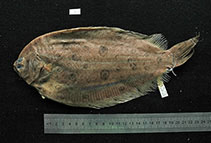| Family: |
Paralichthyidae (Large-tooth flounders) |
| Max. size: |
25 cm SL (male/unsexed) |
| Environment: |
demersal; marine; depth range 10 - 20 m |
| Distribution: |
Southwest Pacific: southeastern Australia northward to southern Queensland. |
| Diagnosis: |
Dorsal spines (total): 0-0; Dorsal soft rays (total): 74-80; Anal spines: 0-0; Anal soft rays: 58-61. Body brownish with 3 ocelli above and below lateral line, and small dark rings and blotches scattered on body and median fins. Body elliptical, its depth 2.1 to 2.3 times in SL. Head length 4.1 to 4.4 times in SL. Upper profile of head with shallow notch in front of upper eye. Snout slightly protruded, shorter than eye diameter, upper-eye diameter 3.8 to 5.2 times in head length. Maxilla extending almost below middle of lower eye. Upper-jaw length 3.9 to 4.6 times in head length. Teeth in both jaws small, close-set, no enlarged canines. Gill rakers slender and rather long. Scales usually cycloid on both sides, but sometimes weakly ctenoid on anterior part of body on eyed side. Pectoral fin on eyed side with 11 or 12 rays. (Ref 9774). |
| Biology: |
Inhabits sand and mud bottoms. Feeds on small benthic animals. Caught mainly with prawn and bottom trawls. |
| IUCN Red List Status: |
Least Concern (LC); Date assessed: 13 November 2019 Ref. (130435)
|
| Threat to humans: |
harmless |
| Country info: |
|
Source and more info: www.fishbase.org. For personal, classroom, and other internal use only. Not for publication.

